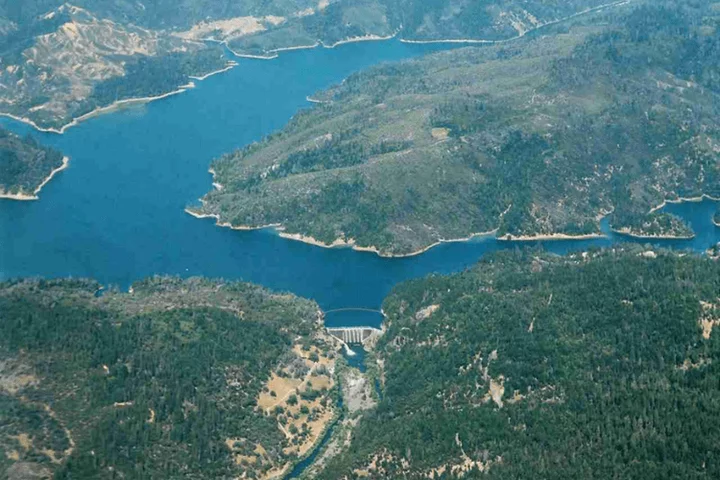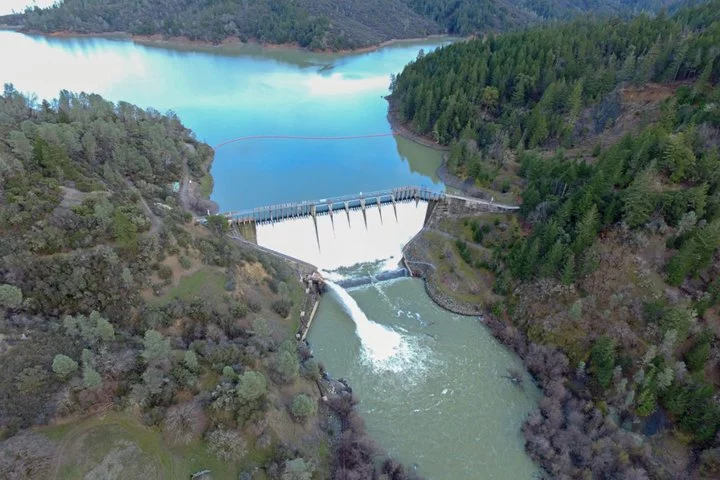Lake Pillsbury and Scott Dam. | Photo via PG&E.
###
Citing increased seismic risk, Pacific Gas & Electric on Thursday announced that it will no longer close the spillway gates atop Scott Dam, allowing more water to flow into the Eel River this spring while lowering the level of Lake Pillsbury by about 20,000 acre feet.
The investor-owned utility has historically closed the gates from April through October, but in a news release PG&E said “new information and updated analyses” revealed a higher level of seismic risk than previous evaluations.
”The most effective means of reducing risk in the near term is to store less water in the reservoir,” the utility said, adding that the decision to leave the gates open was made out of “an abundance of caution” and that the probability of an earthquake severely damaging Scott Dam remains “relatively low.”
“This is a very big deal,” said Scott Greacen, conservation director of the nonprofit Friends of the Eel River. “We think this is just the start of important changes in PG&E’s approach to removing Scott and Cape Horn dams.”
Those two dams, located 20 miles northeast of Ukiah on the Eel River, are components of the Potter Valley Project, a 100-year-old hydroelectric facility (albeit one that no longer produces power) that diverts water from the Eel to the East Branch of the Russian River and blocks salmon and steelhead from nearly 300 miles of spawning habitat in the upper mainstem Eel River.
A coalition of conservation groups last year sued the Federal Energy Regulatory Commission (FERC), saying native fish populations have been harmed by the Potter Valley Project in violation of the Endangered Species Act.
PG&E plans to decommission the project, and on Thursday the company said it will continue developing long-term mitigation measures, “which could include expedited partial or full removal of Scott Dam.”
That’s welcome news to environmental groups that have accused the company of “slow-walking” dam removal. In a press release, Friends of the Eel River said the seismic risk has been well-documented.
“We’ve been raising concerns about dam safety and reliability at the Potter Valley Project for years, so frankly this latest development is somewhat validating,” the group’s executive director, Alicia Hamann, said in the release.
The latest research shows that a fault line running through the reservoir is capable of producing earthquakes up to a magnitude 7, far greater than the magnitude 5.9 that PG&E used for previous seismic modeling, according to Friends of the Eel River.
In response to Thursday’s news, environmental nonprofit California Trout issued a statement that says, in part, “Today’s announcement from PG&E makes it clear that maintaining the status quo for the Potter Valley Project is no longer an option. We continue to encourage Russian River water users that have benefited from Eel River water diversions for the past century to plan for a future without those diversions, or to explore options for an ecologically sound, dam-free diversion facility.”
PG&E says that if federal regulators approve the plan to leave the spillway gates open, only minimum flows of five-to-25 cubic feet per second will be diverted into the East Branch Russian River from now on.
With about 26 percent less water in Lake Pillsbury, there won’t be as much available for summer and fall releases that support cold water fishery resources in the Eel River below Scott Dam — and also less for Russian River agricultural interests. As the Press-Democrat notes, the water releases will never be higher than they were in the 2020 and 2021 drought years.
Beth Salomone, director of the Mendocino County Russian River Flood Control and Water Conservation Improvement District, called PG&E’s move “a devastating blow to water right holders, reservoir operators and all Russian River watershed stewardship efforts.”
But environmental advocates on the North Coast say there’s no sense in prolonging the inevitable, and time is of the essence.
“We need to get our native fish back to their headwaters, and that means removing both Scott and Cape Horn dams,” Hamann said. “As part of their license surrender and decommissioning process, PG&E is due to file a draft plan at the end of this year. Given the latest developments, and the urgency for both salmon recovery and eliminating the risk of dam failure, I expect that plan to outline a method for rapid dam removal.”
Scott Dam. | File photo by Mike Wier, via the Two-Basin Solution website.


CLICK TO MANAGE